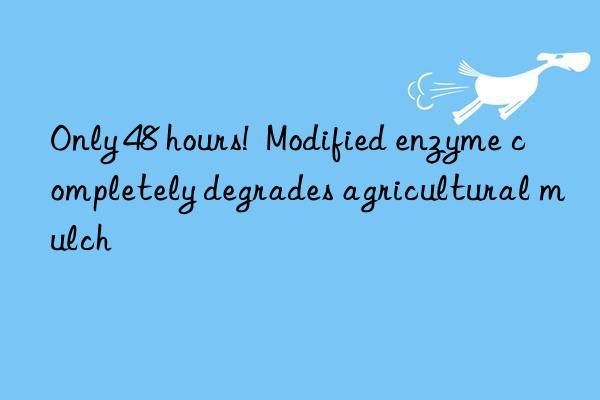
There are abundant crops planted in the farmland, providing people with food for survival. However, the extensive use of agricultural mulch has brought serious white pollution.
PBAT is a new generation of plastic formed by polycondensation of adipic acid, butanediol and terephthalic acid. It has a molecular structure similar to the plastic PET. Due to its excellent ductility, thermal stability and plasticity, it is widely used in industries such as agriculture (agricultural mulch), textile industry and food packaging. However, with the widespread application of PBAT, a large amount of PBAT waste plastics has accumulated, which has brought great pressure to the environment.
Recently, the team of Professor Guo Ruiting of Hubei University and Professor Liu Yingle of Wuhan University, using structural biology and enzymatic techniques, found that cutinase can efficiently degrade polymer PBAT, and at the same time clarified the relevant catalytic mechanism. The study was recently published in Nature Communications.
Two-day rapid degradation of PBAT plastic
Guo Ruiting, the corresponding author of the paper, told the Chinese Journal of Science that bio-enzymatic green degradation of plastics has always been the best solution to the problem of plastic pollution. However, PBAT plastic has a regular crystal-like molecular structure, and the polymer fibers are very closely arranged, so it is very difficult to find degrading enzymes that can "chew" PBAT.
In order to solve the above problems, Guo Ruiting's team finally discovered a cutinase TfCut for degrading PBAT mulch plastic through large-scale screening. This enzyme can quickly decompose PBAT mulch into large fragments and small particles within two days until it disappears completely.
The researchers further separated and identified the intermediates in the degradation process of PBAT, and they mainly found three intermediate products—BTa, ABTa and TaBTa (Ta=TPA), as well as the final product TPA. Observing the changes of these four intermediate products found that ABTa and TaBTa will reach the highest value at about 8 hours, and then gradually decrease until they disappear. After 48 hours, the reaction products were mainly TPA and BTa.
"There are many possibilities for the degradation products of PBAT, but only these four products appear in the process of PBAT degradation by cutinase TfCut, and all of them end in TPA. Therefore, we speculate that there may be a unique mechanism for the degradation of PBAT by TfCut cutinase." The paper. Chen Chunqi, a corresponding author and a professor at Hubei University, said.
It is worth noting that TPA itself, as one of the raw materials for the synthesis of PBAT, comes from crude oil. Affected by the relationship between supply and demand, the price of crude oil has continued to rise in recent years, the production cost of PBAT has risen sharply, and the downstream of the industrial chain has fluctuated greatly, resulting in increased uncertainty.
Liu Yingle, the corresponding author of the paper, said that if the degradation products of PBAT can be collected on TPA, recycled and used to synthesize PBAT or other polymers, the recycling of PBAT can be realized and the consumption of crude oil can be greatly reduced, which has good industrial application value.
Changing products into raw materials to reduce crude oil consumption
Guo Ruiting’s team’s previous research found that after transforming the large dyad (H224-F228) of cutinase TfCut into a small dyad (S224-I228), the activity of degrading PET plastic was significantly increased.
Therefore, they applied this strategy to PBAT degradation. It was found that the engineered TfCut small dyad mutation (TfCut-DM) degraded PBAT for 48 hours, leaving only TPA. Yang Yu, the first author of the paper and associate professor of Hubei University, believes that this result is conducive to the recycling of TPA obtained after the degradation of polymer PBAT.
In addition, the study found that TfCut with small dyads can also efficiently degrade the more difficult-to-degrade PBAT that has undergone cross-linking reactions after being irradiated by ultraviolet rays. This discovery laid a solid foundation for the application research of cutinase to degrade PBAT.
Min Jian, the first author of the paper and associate professor of Hubei University, introduced that by comparing the crystal structure of the complex during the degradation process, they found that the entrance of the active region of the wild-type cutinase TfCut is more prominent, while the modified cutinase TfCut-DM active region is more prominent. The entrance is relatively flat, which is more conducive to the combination of PBAT long chains. This structurally explained the reason for the enhanced degradation activity of TfCut-DM.
Guo Ruiting pointed out that the end products of wild-type cutinase degrading PBAT are BTa and TPA, while the modified cutinase TfCut-DM has higher activity and the end product is TPA, which is more conducive to the recovery and recycling of PBAT enzyme hydrolysis products.
This study lays the foundation for the biodegradation of polymer PBAT and the recycling of the final product TPA.



 微信扫一扫打赏
微信扫一扫打赏
